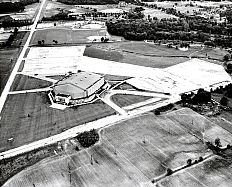1950-1959: DAYS OF CONFLICT, YEARS OF PROSPERITY
North side boomed in postwar era
 |
 |
 |
 |
|
|
|
In the middle of nowhere
When Memorial Coliseum opened in 1950, it was surrounded only by farmland. |
|
|
Railroad elevation and new roads pointed the city's growth to the north.
By
Michael Dawson of The News-Sentinel
In the late 1940s and early 1950s, the cadence of urban growth echoed in most cities across America. It went a little something like this: World War II veterans returned to a healthy economy -- they started families -- they needed housing -- already cramped cities expanded outward.
Fort Wayne was no different. After the war, the city saw the return of more than 11,250 soldiers who needed housing.
By the late 1940s, housing had saturated the south side, which, besides a handful of north-side neighborhoods, was Fort Wayne. The few south-side lots that were available were small and pricey and homes in the older central part of the city had antiquated kitchens and plumbing.
There was demand for new homes, but growth to the north was checked by the Nickel Plate railroad, which still snakes across the north side of downtown.
The heavily traveled tracks, now controlled by CSX Corp., were then on the ground and made traveling north of Main Street difficult because trains frequently blocked the path.
But in 1955, the city, with help from federal and state funding, elevated the tracks, opening up the north side. As traffic was able to move freely through the city, roads on the north side were improved and more housing and retail areas were developed.
At the groundbreaking ceremony on a subfreezing December morning in 1953, then-Mayor Harry W. Baals called the $9 million rail elevation "a dream come true."
The elevation would remove the barrier to the north side of the city, Baals said, and "there will be many more (benefits) we cannot foresee at this time. I can assure you of that."
By the time the elevation was completed in 1955, the Allen County War Memorial Coliseum was open and the U.S. 30 bypass, known now as Coliseum Boulevard, was close to becoming a four-lane road.
The first north-side subdivision was Northcrest, made up of prefabricated National Homes, one of the countries biggest postwar, "economy homes" builders. The late Ralph Shirmeyer was the area's main National Homes dealer. During peak times, Shirmeyer's crews were known to build two homes a day, said his son, Tom Shirmeyer.
Northcrest and the adjacent Northcrest Woods included about 1,200 homes, Shirmeyer said.
Tom Shirmeyer, who worked on some of the building crews when he was a teen-ager, said at the end of every day during the 50s, a new house was ready for a family.
"In the morning, there would be just the concrete foundation, but by evening there would be a house," he said. "We couldn't build them fast enough."
As the law of development dictates, retail development follows residential. In 1957, while the Northcrest subdivisions were being completed, Northcrest Shopping Center was erected.
"Northcrest paved the way for the rest of Coliseum," said Phil Knapke, of Goldstine Knapke Co. "It opened up the city."
Knapke's father, Norbert Knapke, along with other developers, including Ralph Shirmeyer, developed, built and managed the center. Goldstine Knapke Co. still manages the shopping center.
Kroger was the first tenant in 1957, and by 1960, Northcrest Shopping Center was in full swing.
"The north was the wave of the future," said Stephen Steckbeck, one of the owners of Ream-Steckbeck Painting Co. Started in 1914, the paint company opened its second store in Northcrest in 1958. The Northcrest location is still one of his most popular stores, Steckbeck said.
The first north-side shopping center competed directly not with downtown stores, but with stores in Southgate Plaza, which opened in 1955.
Steckbeck said stores that stayed downtown, like the popular department store Wolf & Dessauer, were destined to fail and they did.
Lack of parking and traffic were the problems, Steckbeck said, and still are today.
"Most downtown merchants realized in the 1950s that they were going to have to leave downtown, and the smart ones did," Steckbeck said. "By the late 50s the entire city either shopped at Southgate or at Northcrest. Those who stayed were left to wither on the vine."
Knapke said development of the north side would have happened eventually, even if the train tracks were not elevated. Still, he wonders if growth would have been north.
"Who knows if development would have moved the way it did," Knapke said. "Coliseum may not have become Fort Wayne's retail district."